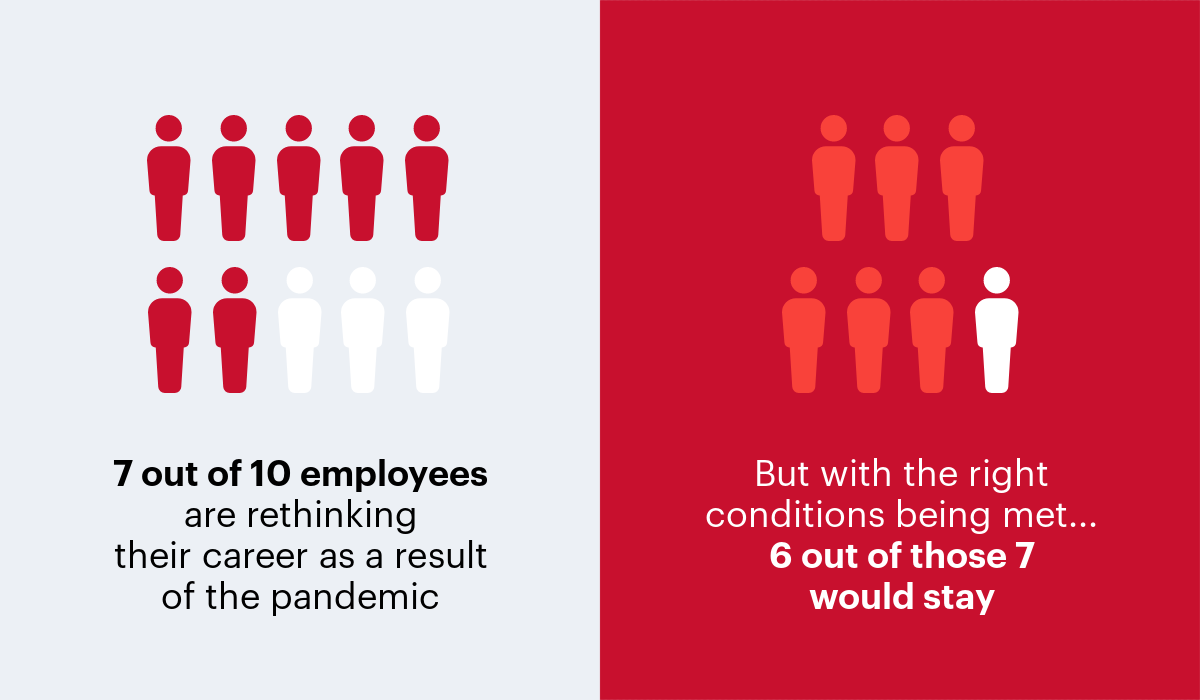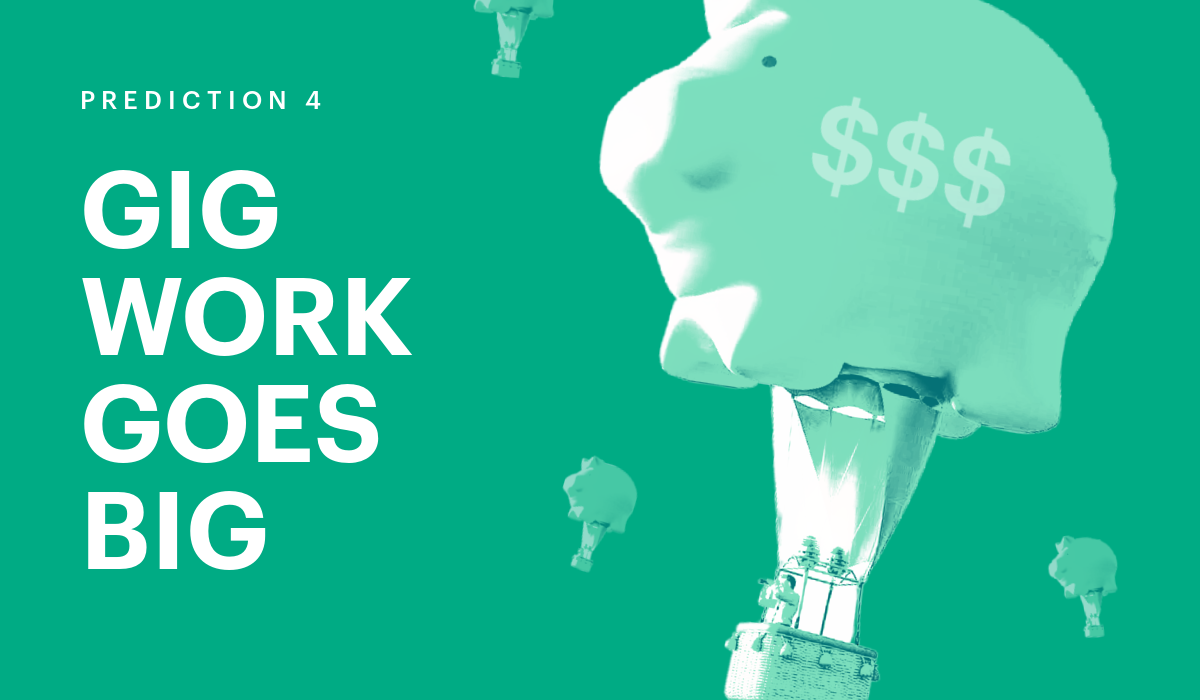What Comes After the Great Resignation?
The workplace has undeniably changed. What comes after the Great Resignation? Here are our seven predictions for what's next.

The Great Resignation has been a hot topic in business and HR circles for several months now. Visier predicted it would kick into full force in the summer of 2021—it did, and it hasn’t relented since then. With a jaw-dropping one-third of the workforce quitting their jobs in 2021, the seismic ripple of the resignation wave has grown into a tsunami. There is no going back to before—the world of work has undeniably changed.

Questions related to this mass workforce exodus are hauntingly similar to questions related to COVID: How long will this go on? And what will happen after it has run its course?
We have seven predictions for what happens after the Great Resignation:
1. Flexible work is a must-have

During the pandemic employees have gotten a taste of what freedom from the workplace, and a daily commute, feels like. They’ve saved money and time on transportation, clothes, meals, childcare, and other common expenses that were customary in the brick-and-mortar work world. They’ve also grown accustomed to greater work/life balance and the ability to simultaneously manage work and family responsibilities.
2. Slow turnover by…being better

Research from LumApps, an employee experience platform, found that 71% of employees are rethinking their career paths based on their experiences during the pandemic. The research, published in two reports, Employee Retention Strategies for the Digital Workplace and The New Era of Employee Recruiting, also suggests that employers that can meet these needs have an opportunity to retain talent—59% of U.S. employees said they would prefer to stay with their current employer “under the right conditions;” and 73% said they like their current roles.

What will it take to keep employees on board? Empathy, according to Ernst & Young’s (EY) 2021 Empathy in Business Survey which reveals 90% of employees believe empathetic leadership leads to higher job satisfaction and 79% agree it decreases employee turnover.
3. Technology adoption increases

Technology—like artificial intelligence (AI), machine learning, robotic process automation (RPA), and of course people cloud platforms like Visier, have been available for some time now. But even though businesses were widely considering ways they could use technology to streamline operations and deliver more—and more valuable—insights, there was no burning platform to move many organizations forward quickly.
That situation has changed since the pandemic. As companies grapple with empty seats, talent gaps, and missed opportunities, their awareness of the importance of the strategic adoption of technical solutions to ensure success and sustainability is at an all-time high.
As Jon Hill, chairman and CEO of The Energists, an executive search firm serving the energy industry says: “Automation and AI will certainly be helpful in filling gaps in the workforce, allowing companies to maintain the same level of output with a smaller staff. Additionally, implementing technology that allows for a distributed or remote workforce can help companies keep a full staff because it expands the range of their available talent pool, giving them access to candidates who aren’t in their immediate geographic area—and without the costs and hassle of relocating employees.”
4. Side hustles and gig work take center stage

Gig workers represent value to employers in a number of ways. The ability to hire employees on a temporary basis to fill talent gaps without taking on long-term risk is obviously appealing. So is the ability to find skills that may be in short supply where employers are physically located. Gig workers often represent an opportunity to “try before you buy.” And gig workers can bring a perhaps unexpected benefit in that these they have experiences with other organizations that can lead to new ideas and innovation.
“People who were once [salaried] employees are becoming contractors or freelancers, using crowd platforms like Expertify to market themselves to companies,” says Andy Binns, a co-founder of Change Logic, and author of Corporate Explorer: How Corporations Beat Startups at the Innovation Game. Employees want the opportunity to be in control of when they work and for how much, says Binns. But, he adds, employers also gain. “They can set demanding contract terms, have lower fixed costs, and, in some areas, drive down wages.”
As remote and hybrid work during the pandemic has raised many employees’ awareness of and demand for flexibility, gig work is likely to remain a viable option for both employees and employers long past the pandemic.
5. Productivity is measured in work output, not hours

Old ways of management dictated that an employee’s productivity was determined by physically seeing those employees at work, busy at their workstations—even if they weren’t actually producing anything valuable. New management measures productivity by the actual output of work, and the business impact of that work.
How is that impact measured? By evaluating people data and business data together to see how people affect the business, and how the business affects its people.
The people cloud is exactly for this purpose. As a new category in business analytics, the people cloud is where business leaders can find answers about how their employees are performing in the context of how the business is performing. According to DDI, organizations who excel at advanced people analytics are three times more likely to outperform their peers.
6. College degrees might not matter as much

Organizations that are feeling the challenges of finding talent during the Great Resignation may come to question whether their educational requirements are valid, or whether they could find skilled talent without educational credentials but with the knowledge, skills, and competencies needed to do the job.
Melissa Venable, Ph.D., education advisor for BestColleges.com, says: “The Great Resignation is in some ways a result of the introspection prompted during the pandemic. As people rethink their goals and priorities, they are making different decisions about school and work than they may have made pre-pandemic,” she explains. “We’ll continue to see college enrollments decline, partly because of an anticipated shift in U.S. demographics. But more importantly, there seems to be more widespread questioning of the cost of a college education and the potential return on an investment that leaves many people with significant debt.”
Recent research from BestColleges found that “while most Americans still think that college improves a person’s employment potential, they also think that the rising cost of tuition is causing many people to decide against going to college.”
People are now choosing alternative educational pathways, Venable says, including technical training programs, bootcamps, and on-the-job training. “I think we’ll see these pathways gain more traction in the coming years as a viable alternative to college as well as a way to augment a college degree and make more rapid career changes.”
7. Humans will truly become “knowledge workers”

As technology frees up people to focus on higher-level contributions to their organizations, employees will have an opportunity to be more strategic and less focused on administrative tasks. They’ll have access to information to help make informed decisions, to identify opportunities for innovation, and to be continually focused on opportunities for improvement.
“Corporations should explore creating more autonomy for employees within the company,” says Binns. He recommends; “Give them a ‘license to explore’ that will allow them to realize more of their entrepreneurial ambitions from inside the company, without sacrificing the sense of purpose and community that define the best workplaces.”
The Great Resignation has served as a wake-up call to employers, HR professionals and others. There will be no “return to normal.” But that’s not a bad thing. Both employees and employers have discovered new best practices and new opportunities through their pandemic era experiences. These experiences will likely serve to reshape the work world for years to come.
Get Outsmart content straight to your inbox
Subscribe to the People Insights Monthly newsletter for actionable insights and stories.
Subscribe now